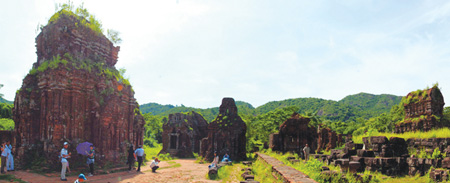My Son tourism village opens
 |
| A community tourism village has opened next to this My Son World Heritage Site in the central province of Quang Nam to boost sustainable local eco-tourism development. — VNA/VNS Photo The Duyet |
The village is one the first steps towards boosting the central province's eco-tourism and sustainable tourism development programme by 2020.
The village, which is home to over 200 people, will provide home-tay facilities and cuisine, cultural performances and eco-tours.
"The province has set a target of developing its tourism industry so it can better contribute to provincial economic growth. The industry also helps to reduce poverty and create jobs for local people in remote and rural area," said vice chairman of the provincial people's committee, Tran Minh Ca. He added that two more community tourism villages in Bhohoong and Dhroong in the mountainous district of Dong Giang would open this June.
The community tourism programme has benefited from the Strengthening of Inland Tourism in Quang Nam Project supported by the International Labour Organisation (ILO) with total funding of US$1.3 million.
"We began a three-year project to support local people through sustainable tourism development in early 2011. Over 42 households in My Son Village have received training on tourism services, English, cooking and customer care," said Nguyen Thi Huyen from the ILO.
"The project has helped to improve local people's incomes. Before, most of them made a living through farming, but now they have another means of making money between harvests," Huyen said.
She said the project aimed to promote community tourism at a local level as an example for the rest of the province.
"Community tourism is the best way for the village to take advantage of the My Son World Heritage Site in a sustainable manner," Huyen added.
She explained that community tourism would help protect the environment by limiting the number of tourists but providing a stable income for local people.
Vo Van Nhut, 38, who attended one of the courses organised by the ILO, said his family's income had sharply increased after opening a home-stay service just a month ago.
"My paddy-field produces five tonnes of rice worth VND30 million (US$1,400) a year, but there's always the risk of natural disasters. It provides just enough food to feed my four-member family," Nhut said.
"I earn VND120,000 ($5.7) for a hard day's work on my farm, but I can make VND150,000 ($7) per hour from guiding tourists around the village," he explained. "My wife cooks for our guests and charges VND80,000 ($3.8) for dinner. We can also earn more money from overnight stays and bicycle rentals."
Nhut said villagers were eager to take part in community tourism after harvest time. The village welcomed around 100 tourists in the first month.
Huyen said the project also encouraged local people to continue their agricultural work to give the village the authentic feel that tourists were looking for.
"We also plan to work with travel agencies that provide kayaking and trekking in the community," Huyen added.
Quang Nam Province has already successfully launched community tourism activities such as farming, fishing, boating, biking and pottery in Hoi An. The central province has great tourism potential, with its history, traditions, culture and environment, as well as two UNESCO-recognised World Heritage Sites – Hoi An Town and the My Son Sanctuary – and the world biosphere reserve of the Cham Islands.
It welcomed 2.5 million visitors in 2011, 40 per cent more than in 2006. Last year that figure rose to a record 2.8 million tourists, of which 1.3 million were foreigners, earning VND1.4 trillion ($67 million).
What the stars mean:
★ Poor ★ ★ Promising ★★★ Good ★★★★ Very good ★★★★★ Exceptional
Related Contents
Latest News
More News
- The destinations powering Vietnam’s festive season travel demand (December 04, 2025 | 18:33)
- Vietnam named among the world’s most exciting winter destinations (December 04, 2025 | 15:10)
- Phu Tho emerges as northern Vietnam’s new tourism hub (December 01, 2025 | 17:00)
- Vietjet completes Airbus A320/A321 updates ahead of deadline (December 01, 2025 | 09:49)
- Vietjet resumes Con Dao flights from early December (November 28, 2025 | 15:24)
- Free tickets, Lunar New Year promotions on offer at Vietjet Mega Livestream (November 26, 2025 | 15:32)
- Scandinavian Airlines and Vietnam Airlines broaden agreement with new routes (November 25, 2025 | 17:04)
- Halong Cruise Port welcomes over 3,100 international visitors (November 12, 2025 | 18:06)
- Vietnam.travel climbs to second place in Southeast Asia website rankings (November 12, 2025 | 18:01)
- Cat Ba named among Southeast Asia’s top island adventures (November 11, 2025 | 18:09)

 Tag:
Tag:



















 Mobile Version
Mobile Version